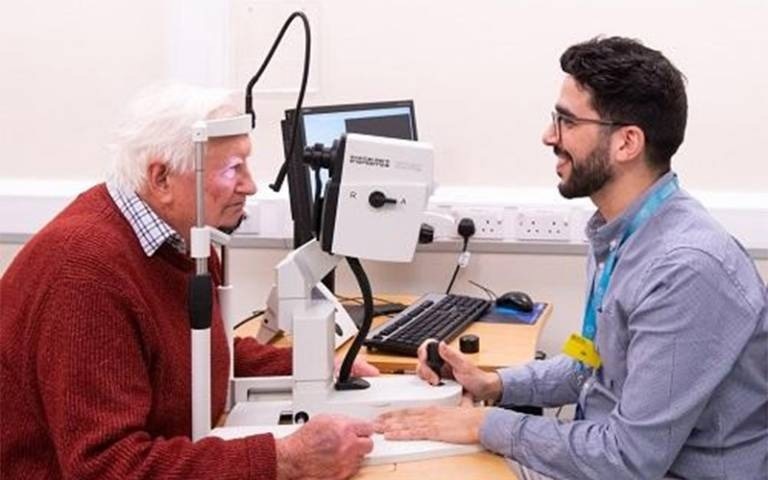At University College London (UCL) and Moorfields Eye Hospital, scientists have come up with an artificial intelligence (AI) system that could not just determine sight-threatening eye diseases but also forecast general health, such as stroke, heart attacks, and Parkinson’s disease.

Image Credit: Moorfields Eye Hospital
RETFound, one of the first AI foundation models in healthcare and the first in ophthalmology, was made utilizing millions of eye scans from the NHS.
The research group is making the system open-source, freely available to utilize by any institution across the world, to act as a basis for global measures to detect and treat blindness with the help of AI.
This study has been reported recently in the journal Nature.
Advances made in AI continue to expedite at a dizzying pace, with excitement being produced by the development of “foundation” models like ChatGPT. A foundation model explains a very large, complex AI system trained on massive amounts of unlabelled data, which could be fine-tuned for various ranges of tasks.
RETFound constantly exceeds present advanced AI systems throughout a range of complicated clinical tasks, and even more significantly, it fulfills a considerable shortcoming of several present AI systems by functioning well in diverse populations and also in patients having rare diseases.
This is another big step towards using AI to reinvent the eye examination for the 21st century, both in the UK and globally. We show several exemplar conditions where RETFound can be used, but it has the potential to be developed further for hundreds of other sight-threatening eye diseases that we haven’t yet explored.
Pearse Keane, Study Senior Author and Professor, Institute of Ophthalmology and Moorfields Eye Hospital, University College London
Keane added, “If the UK can combine high quality clinical data from the NHS, with top computer science expertise from its universities, it has the true potential to be a world leader in AI-enabled healthcare. We believe that our work provides a template for how this can be done.”
AI foundation models have been referred to as “a transformative technology” by the UK government in a report published earlier in 2023, and have come under the limelight with the launch in November 2022 of ChatGPT.
It is a foundation model that has been trained with the help of immense quantities of text data to come up with a versatile language tool. Considering a similar method with eye images in a world-first, RETFound has been trained on millions of retinal scans to make a model that could be adapted for possibly limitless uses.
One of the main difficulties when coming up with AI models is the requirement for expert human labels, which are often costly and tedious to acquire. As illustrated in the study, RETFound is able to correspond to the performance of other AI systems while utilizing as little as 10% of human labels in its dataset.
This enhancement in label efficiency has been achieved by utilizing an innovative self-supervising method in which RETFound masks parts of an image and further learns to forecast the missing portions by itself.
RETFound could help enhance the diagnosis of a few of the most debilitating eye diseases, such as glaucoma and diabetic retinopathy, and forecast systemic diseases like heart failure, Parkinson’s, and stroke.
Determining general health problems through the eyes is an emerging science known as “oculomics”–a term coined in 2020 by Professor Alastair Denniston, one of the study’s co-authors. The eye is a “window” into health, offering a non-invasive look at the nervous system.
Gaining insights into the eye-body relationship is key to approaching complicated diseases and the overall issues linked to aging.
Besides, RETFound has displayed that it is equally effective in detecting disease across various populations.
By training RETFound with datasets representing the ethnical diversity of London, we have developed a valuable base for researchers worldwide to build their systems in healthcare applications such as ocular disease diagnosis and systemic disease prediction.
Yukun Zhou, Study Lead Author and PhD Student, Center for Medical Image Computing, UCL Medical Physics and Biomedical Engineering, and Moorfields Eye Hospital, University College London
RETFound was trained with a hand-selected dataset of around 1.6 million images from Moorfields Eye Hospital. This utilized AI tools and infrastructure offered by INSIGHT, the NHS-headed health data research hub for eye health based at Moorfields and the world’s largest bioresource of ophthalmic data.
The hub’s strong computing and AI capabilities developed from a 2016 research collaboration between Moorfields and DeepMind, now Google DeepMind.
The research group, headed by Yukun Zhou and Professor Pearse Keane of Moorfields and UCL, has made the model to be freely available for use on GitHub. Scientists across the world, such as in China and Singapore, have been making use of RETFound in their novel examination of eye diseases.
This project involved a collaborative effort between NIHR Moorfields, UCLH, and NIHR Birmingham Biomedical Research Centres, bringing together the Computer Science and Engineering teams at UCL.
Journal Reference
Zhou, Y., et al. (2023). A foundation model for generalizable disease detection from retinal images. Nature. doi.org/10.1038/s41586-023-06555-x